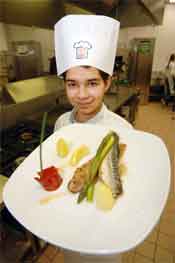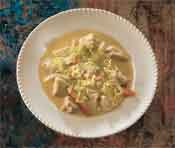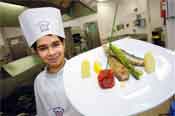Cooking for Ireland - Clifford's Gourmet Irish Stew - Fresh mackerel with oatmeal in nut brown butter & lemon - Watercress
 Ireland’s food culture has seen momentous changes over the last thirty years and, while many of these changes have been for the better – especially the growing strength of the artisan food sector - classically trained chefs are increasingly thin on the ground these days, which makes the untimely death of Michael Clifford just before Easter all the sadder.
Ireland’s food culture has seen momentous changes over the last thirty years and, while many of these changes have been for the better – especially the growing strength of the artisan food sector - classically trained chefs are increasingly thin on the ground these days, which makes the untimely death of Michael Clifford just before Easter all the sadder.
Although he was not perhaps the household name that he deserved to be – possibly because he saw a chef’s place as being in the kitchen, and had no apparent ambition to become a celebrity – Michael was one of our finest chefs and will be much missed, not only by those who had the privilege of dining in Clifford’s of Clonmel, which he and his wife Deirdre opened relatively recently, but also those who remember his dedication to the finest of local Irish produce and creative cooking in some key establishments - including the Ryan family’s Arbutus Lodge in Cork, Peter & Alicia White’s stunning Dublin restaurant Whites on the Green, and his own first restaurant Clifford’s of Cork, which he and Deirdre set up long before the Celtic Tiger made dining out an everyday experience for people in Ireland.
Michael was one of the pioneers of the modern Irish cooking that we now take for granted; he worked closely on recipe development with Bord Bia, and was one of the first ‘fine dining’ chefs to see that informality was the coming thing - Clifford’s Bistro operated alongside the posher Clifford’s Restaurant in Cork, and Michael’s 1994 cookery book Irish Bistro Cooking (Mercier Press) reflected his interest in making good food more accessible to everyone. He was also a great teacher and his son Peter, now 15, is also a budding chef and ‘carrying the torch’ for his father - among many things of which his father would be proud, he wowed the judges of the Tesco Young Cook of the Year Competition this spring with a great menu and kitchen skills which saw him take the national title at a cook-out in Dublin earlier this month.
 Clifford's Gourmet Irish Stew
Clifford's Gourmet Irish Stew
Adapted from a recipe in Michael Clifford’s Irish Bistro Cooking, this was one of a collection of enduring house specialities at the Clifford’s Restaurants – and became the definitive modern Irish Stew, as used by Bord Bia when showcasing ‘the food island’.
Serves 4-6:
1kg (2 lbs) shoulder of lamb, well trimmed and diced (keep the bones)
2 carrots, chopped
1 onion, chopped
2 small white turnips, chopped
4 potatoes, chopped
2 sticks celery, chopped
1 leek, finely sliced
Salt and black pepper
50g (2 oz) approx. green cabbage, finely shredded
125ml (1⁄4 pt) cream
Dash of Worcestershire sauce
Chopped parsley
Place the lamb in a large pot. Cover with cold water and bring to the boil. Drain and rinse the lamb, then place in a clean pot. Add the bones to the pot, cover with approx. 1 litre (2 pts) water and add the prepared vegetables, except the cabbage. Season. Cover the pot and cook gently for about one hour, or until the meat is tender, then remove the bones from the pot.
To finish the sauce, remove about 250ml (1⁄2 pt) of the liquid and vegetables from the pot. Process this with the cream and return to the pot with the finely shredded cabbage. Add the Worcestershire sauce. Simmer for 5-10 minutes, until the cabbage is heated through. Check the seasoning. Add the parsley and serve in deep plates.
 SHORT ITEM – At the Tesco Young Cook of the Year Competition (open to children aged 10-16), the five regional finalists each had to devise a 2-course menu using original recipes and the winner, Peter Clifford of CBS High School, Clonmel, Co Tipperary, cooked this main course of fresh mackerel, followed by a lasagne of fresh pineapple with tropical fruits.
SHORT ITEM – At the Tesco Young Cook of the Year Competition (open to children aged 10-16), the five regional finalists each had to devise a 2-course menu using original recipes and the winner, Peter Clifford of CBS High School, Clonmel, Co Tipperary, cooked this main course of fresh mackerel, followed by a lasagne of fresh pineapple with tropical fruits.
Fillet of fresh mackerel with oatmeal in nut brown butter and lemon.
Serves 4:
4 medium fresh mackerel (filleted &
scaled)
Salt and pepper to taste
3 tbsp flour, or as required
2 large beaten eggs
6 tbsp oat flakes, or as required
6 tbsp melted butter, or as required
2 large lemons (one for juice and one for garnish)
Wash and dry the mackerel.
Remove pin bones from mackerel, season and dip each fillet into the flour, then into the egg, then into the oatflakes, making sure that all the fillets are evenly coated. Melt half of the butter in a large frying pan and heat until it begins to foam. Place the fish in the pan over medium heat until the oatmeal is browned (make sure not to burn); this will take approx. 5 minutes, or less, depending on the size of the mackerel. Cook on both sides. Add the remaining butter and lemon juice, reserving one lemon for garnishing. Serve with new season asparagus and turned potatoes.
INGREDIENT OF THE WEEK: WATERCRESS
WHAT IS IT? This peppery green-leafed salad herb, aka‘Rorripa nasturtium aquaticum,’ is a member of the cruciferae family and so related to broccoli, cabbage, brussels sprouts – and, more surprisingly perhaps, horseradish and pak choi. It is very rich in vitamins and minerals, notably vitamin C, calcium and iron; currently an ‘in’ food (‘the fashionable ingredient to be serving this spring’) its history as a medicinal herb goes back thousands of years and it is now regarded as a superfood with ‘amazing nutritional properties and cancer fighting potential’. Watercress contains high levels of phenyllethyl isothiocyanate, a compound which gives it the peppery flavour and has been shown to increase the body’s potential to resist certain carcinogenic agents. (A research project at the University of Ulster is currently under way).
WHERE DOES IT COME FROM? In the wild it grows profusely in fresh running water, in streams and rivers; in the UK it is farmed in areas like Hampshire and Dorset, where pure spring water is drawn from deep under the chalk downs.
WHERE CAN I GET IT? Providing you are certain that the water is unpolluted, watercress leaves can be picked from streams, and this is the ideal time of year to harvest it. It’s also available from farmers’ markets, greengrocers and good supermarkets – but check the label before buying, to see how far this simple native green has travelled.
WHAT CAN I DO WITH IT? Watercress is not just a garnish but a valuable early season herb and salad vegetable: chop finely and add to dressings for piquancy, or use as a main ingredient in a green salad – it has a special affinity with oranges, and also goes well with tomatoes (and blue cheese). Together with potato, it makes a classic soup, or a pleasingly peppery mash, and it enlivens other staple foods like rice. It is also used in a classic sauce for fish, especially salmon, which is coming into season in spring, at the same time as watercress – a natural partnership.





There are currently no comments
Leave a comment
Not a member? Register for your free membership now!
Or leave a comment by logging in with: